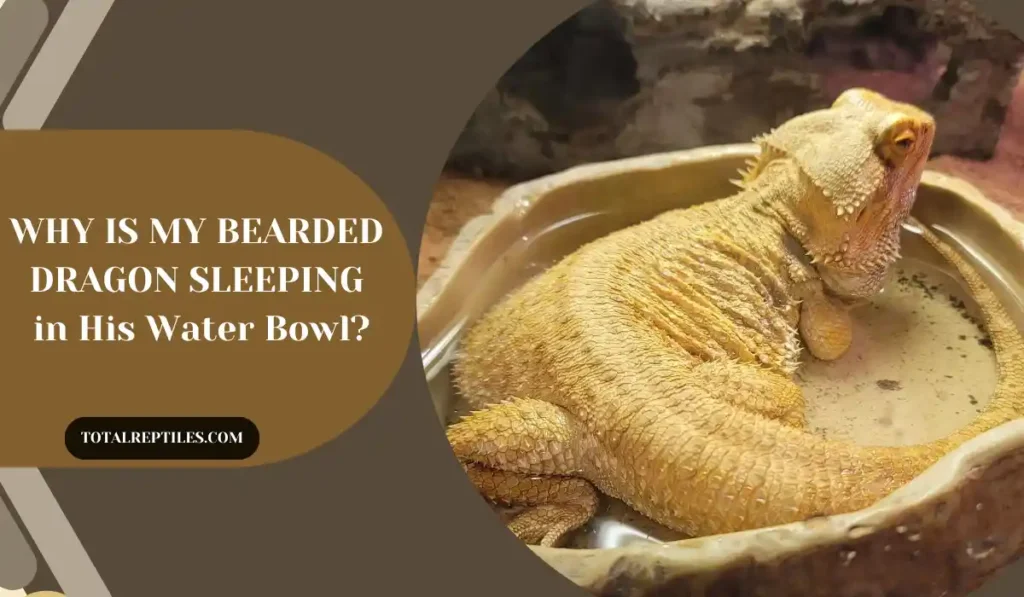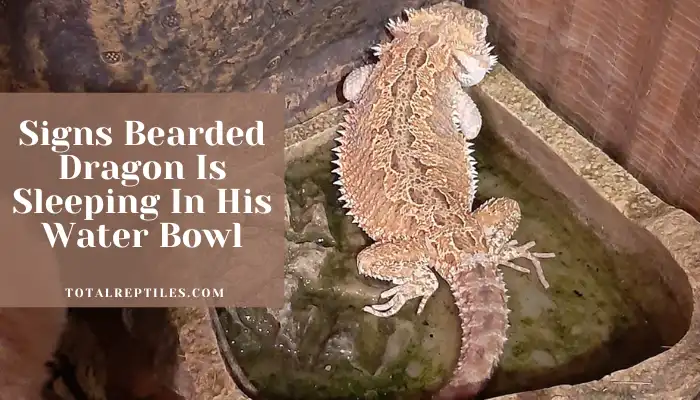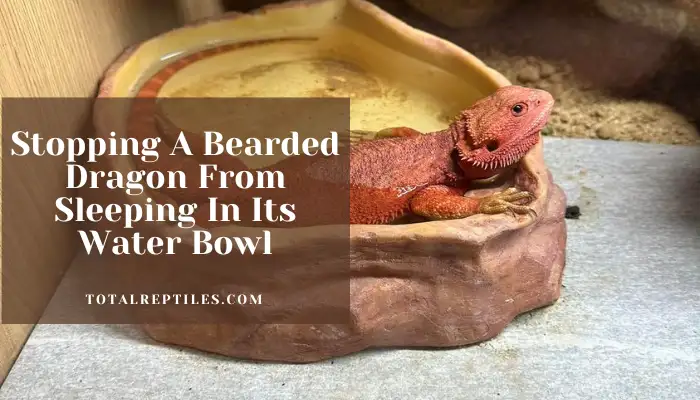Bearded dragons have many interesting behaviors, but owners often wonder why their dragons sleep in their water bowls. This peculiar habit can be alarming for owners who worry about possible health risks. This detailed guide explaining this behavior lets you know when it’s okay and when to worry.
Dragon enthusiasts lovingly accept these reptile eccentricities. However, finding your soggy dragon sleeping in his water dish can cause more significant worry. Let’s first understand why this behavior manifests before assessing any risks.

Why Do Bearded Dragons Sleep in Water Bowls?
In the wild, bearded dragons evolved sleeping behaviors to aid their survival. They are diurnal baskers by nature, meaning they soak up sunshine and heat during daytime hours.
They use tree hollows, caves, and crevices before nightfall to hide. Their captivity habitat lacks many cozy nighttime hiding spots, so an available water container can look inviting.
Bearded dragons do not require water bowls in their habitat setup. Unlike some reptiles, they gain moisture from eating fruits and vegetables versus drinking. Some reasons why your dragon may specifically choose a water bowl include:
Thermoregulation
- Bearded dragons are ectothermic, relying on external heat sources to regulate body temperature
- In captivity, the ambient air may not cool off sufficiently at night
- Lounging in shallow water can aid in cooling down
Humidity
- Low humidity can exacerbate respiratory infections and problematic shedding
- Soaking in their bowl creates a humid microclimate
Safety
- Instinct tells them to hide out at night to avoid threats
- A water bowl, especially with a cave-like decor exterior, Feels protective
Comfort
- The textured bottom surface and snug dimensions appeal as a comfort spot
- Being lower to the ground feels secure.
As you can see, your bearded dragon’s requirements and instincts explain its strange behavior. The water bowl may offer cooling, humidity, security, and comfort—a winning combination!
Dangers of Water Bowl Sleeping
Allowing quirky behaviors that don’t cause harm would be acceptable in a perfect world. Leaving a bearded dragon unattended in a water bowl poses some risks requiring precaution.
Drowning
A dragon that falls into a deep water basin can quickly drown if unable to get their head above water. Even in shallower bowls, an overnight accident could turn tragic.
Chilling
Although cooling down during the day is healthy, becoming too cold at night can stress their metabolism and immunity.
Respiratory Infection
Bacteria thrive in stagnant water and damp environments. Without treatment, prolonged exposure can induce upper respiratory infections and reptile pneumonia.
Parasites
Mites, protozoa, and mold can spread quickly when conditions are unsanitary.
Impaction
Swallowing bits of substrate or decor while soaking could cause intestinal impaction or blockage.
Water bowl sleeping is logical, yet it poses avoidable risks.
Signs Your Bearded Dragon is Sleeping in His Water Bowl
Catching your lizard lounging in his bowl may be unexpected if they usually turn in for bed elsewhere. Pay attention to these giveaways that it’s become a nightly ritual:

- Spotting them dozing inside or partially inside the water basin
- Finding them soggy when you wake them up in the morning
- Noticing water stains on their beard or body after a night’s sleep
- Catching them in the act when finishing up evening maintenance checks
- Empty bowls that still contained water at their bedtime
Sometimes, it starts as a sporadic thing but becomes a predictable habit. The fact they keep returning means they find it a comforting refuge.
Is It OK for a Bearded Dragon to Sleep in Water?
Not! We mentioned the potential health risks of a bearded dragon sleeping overnight or during the day in the water. It puts Beardie in danger of lung infection, drowning, digestive difficulties, and temperature-related diseases.
Instead, you will need to implement some deterrents paired with appealing alternatives that meet their comfort needs in safer ways.
Concerns About a Bearded Dragon Sleeping in Water
Some owners understandably have lingering questions about allowing the behavior or their pet’s health. Let’s review a few common worries:
Can it cause dehydration or overhydration?
- Extended water contact does not hydrate them. Their skin is not permeable
- it can leach away body heat required for metabolism
- Overhydration is only a risk if they accidentally gulp too much water
Do sinking bowls pose a bigger risk?
- Yes, a heavy bowl that tips over with the weight of a leaning dragon is extremely dangerous
- Similarly, smooth-sided containers could lead to accidental slipping into deeper waters
Can secondary drowning happen after leaving the water?
- It’s unlikely but possible if enough water entered the airways to affect breathing later
- Signs include coughing, wheezing, lethargy, or mucus secretions
Will it make a respiratory infection worse?
- Yes, if you are already battling an infection, the added dampness and chilled body further tax your immune response.
Stopping a Bearded Dragon from Sleeping in Its Water Bowl
While the reasons for water bowl sleeping seem plentiful, the risks require solutions. You can reduce the behavior and improve sleep with habitat changes and deterrents.
Remote Access
The most direct approach is removing the water bowl at night. Use a shallow, sturdy ceramic crock during daytime hours for adequate hydration. Then delete it after lights out. You must ensure they have sufficient fluids from their diet or consider very brief misting.
Utilize Safer Bowls
If eliminating water overnight is unfeasible, utilize bowls with the following safety features:
- Hefty weight to avoid tipping
- Smooth, not slippery surfaces
- Steep, not sloped sides
- Very shallow water capacity
- Too small to fit the whole body
Check that dimensions allow easy head dipping for drinking but deter full-body soaking attempts.
Add Deterrents
simply removing access or using restricted bowls still leaves them seeking out the spot. Adding physical deterrents boosts the chance they’ll move on:
- Pointed river rocks
- Chicken wire
- Double-sided carpet tape
- Indirect heat source
- Motion-triggered devices
The goal is to make attempted entry unpleasant enough that they choose alternative spaces. Be sure any deterrents avoid actual harm or hazardous contact.

Adjust Photoperiod
Creating a clear day/night cycle supports sleep readiness when darkness falls. Make sure the habitat allows the following:
- 10-12 hours of uninterrupted daylight
- 12-14 hours of full darkness
- Slow transitions between (simulate dawn/dusk)
This syncs their circadian rhythm for more predictable bedtime behavior sans water bowls.
Expand Hideout Options
The primary motivation for water bowl snoozing is feeling safe. Ensure their habitat offers plenty of enclosed shelters and high-vantage sleeping perches. Add new structures periodically to renew interest and opportunities to discover secure spots.
You can resolve the water bowl sleeping issue with some adjustments by realigning their habitat space to synchronize with natural bio-needs.
What to Do if Your Bearded Dragon Won’t Stop Sleeping in Water
Introducing the above changes will curtail any nighttime water bowl sleeping. Every Beardie has unique stubborn streaks. Yours may persist despite adding deterrents and appealing spaces. Now what?
First, double check your husbandry practices cover all best care recommendations:
🔺 Correct UVB lighting, gradients, photoperiod
🔺 Proper temperatures across the enclosure
🔺 Appropriate substrate and habitat decor
🔺 Regular thorough sanitization procedures
🔺 Healthy, balanced, varied vitamin-rich diet
Ruling out underlying issues is step one. Persistence could signal their needs are unmet in some way.
Check for possible health concerns making existing spaces uncomfortable:
🔺 Fungal or bacterial infections
🔺 Skin irritation or lesions
🔺 Bowel trouble like parasites or impaction
🔺 Onset metabolic bone disease
If adjusting the habitat and your care regimen shows no lapses, the next recourse is scheduling a veterinary wellness exam.
Continued water sleeping despite removing access and fulfilling health needs suggests an obsessive behavioral disorder may be developing.
With their guidance, you can show your stubborn sleeper safer ways to bed down at night. Your patience and dedication to meeting their needs will overcome problematic water obsession quickly.
FAQ
Is it dangerous for baby bearded dragons to sleep in water?
Potentially more risky. Babies risk chilling faster with their smaller body mass. Their developing immune systems also increase susceptibility to bacteria and parasites from unsanitary water.
Can sleeping in water cause tail rot?
Direct contact with water does not cause tail rot or tissue infection. Persistently damp conditions may contribute by allowing infectious agents to thrive.
What temperature should a bearded dragon’s water be?
Ideal water temps range from 80-85°F to encourage proper hydration. Cooler water discourages drinking. Use submersible heaters with a separate thermostat to automatically maintain temperatures.
conclusion
This guide gives you peace of mind if your weary bearded dragon is napping in his water bowl. They curl up for sensible reasons, but persistent contact causes health risks that require attention.
Restricting access, providing deterrents, broadening habitat possibilities, meeting ignored needs, and ruling out disease reduce the behavior. Your wet dragon can sleep peacefully every night if you care for them and provide for their needs.
Trust the process and realize that no bowl will tempt them to sleep eventually. When such tweaks work, you and your pet can relax.

